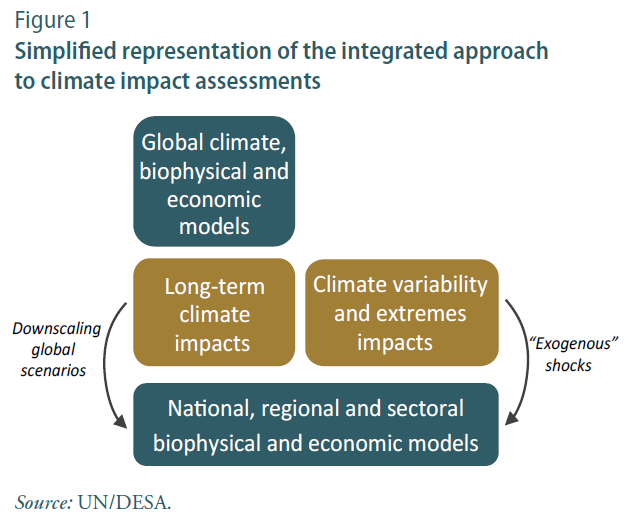
The challenge of addressing diverse environmental concerns in development policy
The intensity and frequency of climate hazards have increased with climate change, imposing large costs on societies. Building resilience to withstand climate hazards requires improved understanding of possible impacts from climate change and the policy options that, by preventing loss of lives and livelihoods in the face of such impacts, improve development prospects. However, bringing the science of climate change to development policy is not simple; in fact, integrating the many facets of environmental concerns into development policies is a major challenge in the implementation of the 2030 Agenda for Sustainable Development.
Based on the experience of the past decades, policymakers have gained better understanding of the links between the economic and social dimensions of development. But it took several years and improved data and analytical capacities to move away from the narrow focus on economic growth as the main source of development. Now there is a better understanding of the characteristics of households and the sources of people’s vulnerability to economic shocks. The policy frameworks that enhance consistency between economic and social policies have also been strengthened, including through the construction of improved analytical tools to assess policy options and development impacts. However, environmental concerns and the impact of climate hazards on people’s livelihoods need to be better understood. Addressing these challenges requires improved policy frameworks and analytical capacities to assist in the design and implementation of coherent policies across the economic, social and environmental dimensions of development. In fact, the 2030 Agenda calls for strengthening the science-policy interface and for the incorporation of evidence-based instruments to support policymakers in promoting poverty eradication and sustainable development. It is thus important to bring together the different methodologies available to support integrated assessments of development challenges, including building climate resilience. Consideration of options for achieving climate resilience for sustainable development is a complex task. It requires good information systems that provide the data and statistics necessary to identify people at risk in their geographical contexts, which are often local. It also requires improved integrated assessments of possible impacts of climate hazards on people and their livelihoods, including sound analysis of policy options for building resilience in anticipation of such impacts or, when they occur, for providing assistance in coping with and recovering from them. These assessments, in turn, require knowledge across disciplines belonging to the natural and social sciences, as well as local knowledge. Thus, integrated assessments extend beyond the traditional expertise of the development community and the scientists working within their own disciplines.
Integrated assessment is already a well-developed framework
For several years now, the international community of natural and social scientists has made significant progress in the development of methodologies to assess plausible impacts from climate change. Existing methodologies make climate projections and generate scenarios of potential impacts on ecological and human systems, including an assessment of policy options to address most negative impacts. Scenarios from integrated climate impact assessments rely on climate, biophysical and economic models (figure 1). Global climate models make projections on climate change—typically changes of temperature and precipitation patterns—over relatively large spatial and temporal scales. These projections are subsequently "downscaled" through global biophysical models to simulate how they affect natural resources such as land, water or energy. To further the analysis, global economic models are used to generate scenarios that translate changes in natural resource systems into changes in socioeconomic systems. The cascade of impact scenarios from these global models can be subsequently downscaled to estimate potential impacts at country level, regions or sectors. Scenarios can also be developed at any of these levels to assess policy options available to offset or prevent adverse impacts or to reduce vulnerability. The integration of diverse models in assessing impacts and policy options is an important tool for taking proper account of the interlinkages "within" and "across" the different dimensions of sustainable development. For example, a biophysical model representing a natural resource system independently, be it land, water or energy, is useful in its own right. However, a more holistic approach that helps to represent the way those three natural resources are integrated is better suited for understanding how changes in one resource (resulting from a changing climate, for example) may impact other resources. Integrated assessments in this case also shed light on ways to improve the allocation of natural resources to meet the sometimes competing demands for crops, water and energy services, or to achieve broader adaptation objectives. As an example, consider an analysis of energy pathways that relies exclusively on an energy systems model. In this case, the analysis would be incomplete if it did not include systems models for water and land to account for future changes in rainfall and land-use associated with climate change. An integrated approach to natural resource systems analysis allows for an understanding of how climate-sensitive natural resources are influenced by climate hazards and how, in turn, the livelihoods that depend on those resources are affected. Other models that represent the economy-wide functioning of the world, a country, region or sector further help to understand how changes in climate-sensitive natural resources may impact the economy and the generation of income associated with different types of livelihoods. The analysis can be supplemented with the use of household surveys to capture the resulting distributional impacts at the household level. Furthermore, integrated assessments at these different levels are also useful in assessing the policy options available to address these challenges. The integration of all these methodologies offers the opportunity to capture the multiple interlinkages across the environmental, economic and social dimensions of development. For several years now, the scenarios developed with these methodologies are informing international climate discussions and feature prominently in supporting conclusions and recommendations of assessment reports of the Intergovernmental Panel on Climate Change (IPCC). These scenarios are also used by some countries to assist decision makers in designing interventions to reduce adverse impacts from climate change. However, it is necessary to sharpen the development focus of integrated climate impact assessments and overcome capacity and data constraints, in order to enhance their relevance in decision-making.
Areas for improving integrated assessments
It is critical to expand the assessment of policy questions beyond mitigation, in order to include adaptation and resilience. The most common use of integrated assessments so far has been in the area of long-term mitigation, where the objective variable is well identified and has common reference metrics in tons of greenhouse gases and radiative forcing values. Expanding the use of these methodologies for adaptation and resilience brings a new layer of complexity in the sense that adaptation and resilience are interwoven with broad development goals (i.e., reducing vulnerability to climate hazards requires livelihood improvements, food security, improved health systems, infrastructure development and better educational services). Expanding the use of integrated climate impact assessments to assess policy options will help to integrate the different dimensions of development, including adaptation and resilience. It is also important to expand the narrow focus on long-term climate change to include assessments on the impact of climate hazards that are caused by climate variability and extreme weather events. There is ample evidence of the severity of impacts from climate extremes and variability on people and livelihoods. Integrated assessments can help generate an order of magnitude of potential "exogenous shocks" that climate hazards inflict on natural resources and socioeconomic systems, which is key information for assessing policy options to build resilience (as shown in figure 1). Assessments are incomplete if they do not consider the broader economic repercussions and macroeconomic feasibility of policies for climate resilience. The tendency has been to use aggregate economic models to account for the costs and benefits of, typically, a single project or intervention. However, analysing the economy-wide repercussions and macroeconomic feasibility of multiple policies requires the use of more comprehensive modelling approaches. Most importantly, the need to scale up multiple investments in order to build climate resilience and the need to close the financial gap to facilitate such investments require the use of economy-wide models able to capture the repercussions, including trade-offs and synergies, of large-scale policies: for example, in integrated assessment it is necessary to determine if the allocation of funds to finance policies aimed at climate resilience would crowd out other climate and non-climate investments with unintended consequences for the economy. Importantly, bringing inequalities to the forefront of the analysis is an urgent task to enhance the relevance of integrated assessments in decision-making. Integrated climate impact assessments have not systematically addressed the way in which inequalities exacerbate vulnerability to climate hazards, let alone considering policy options to address structural inequalities with a view to building climate resilience. Inequalities can be featured more prominently in integrated climate impact assessments through a mix of models. Four sources of inequality that are worth exploring using existing models are: (i) climate-sensitive natural resources upon which livelihoods rely (using biophysical models); (ii) distribution of income on the basis of ownership and employment of production factors (using economy-wide models); (iii) human capital and access to basic public services and resources (using economy-wide models); and, (iv) socioeconomic attributes (explored through household survey and microsimulation analysis). Multiple recent efforts are contributing to advancing the science of climate change and the use of integrated methodologies to address the multiple impacts of climate change on human systems. Due to the holistic character of the 2030 Agenda for Sustainable Development, its implementation will certainly increase the demand for integrated assessment approaches as the basis for coherent policy formulation. Hence, there is an urgent need to support developing countries to strengthen their capacity to improve the use of integrated assessments as a tool for policymaking. In many developing countries, there are data and technical capacity constraints on the use of modelling tools as part of routine policymaking assessments. Policymakers in those countries therefore rely mostly on partial quantitative assessments, qualitative evaluations or value judgments. While these partial approaches are useful and necessary in policymaking, they do not fully capture the interlinkages among the different dimensions of development. Developing capacity to design and use integrated impact assessments will enable policymakers in developing countries to support their policy dialogue with scientific evidence (within the margin of uncertainty surrounding modelling methodologies). It is, then, necessary that the international statistical and modelling communities effectively support the development of this capacity.
 Welcome to the United Nations
Welcome to the United Nations